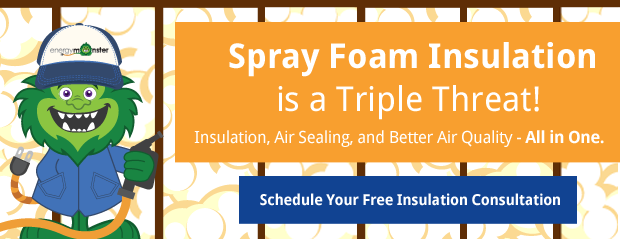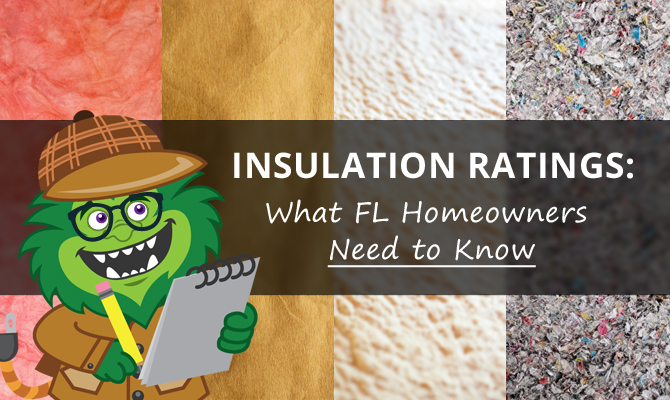As October comes to a close, many people around the country are bracing for a winter full of snow and ice. And while many Floridians are expecting temperatures to drop as we get into the winter months, right now air conditioners are still humming across the state. The downside of living somewhere that’s warm for so many months of the year? You nearly faint every time your energy bill arrives. So what can you do about high energy costs? Make sure your home is properly insulated! Insulation serves as a barrier between you and the outside world. It keeps that air conditioned air inside so you don’t have to spend so much on cooling costs. How do you even begin to assess your insulation needs? Start by learning about the insulation ratings and the different kinds of insulation ratings.
What Are Insulation Ratings?
There are many different types of insulation, and they vary in effectiveness. Each type of insulation has an R-Value, which is defined as the ability to resist heat flow. The higher an insulation’s R-Value, the better it is at preventing heat loss and air escape. The following table gives examples of common types of insulation and their average R-Values.
| Type of Insulation | R -Value |
| Kraft Faced Batt | R-2.9 to R-3.8 per inch of thickness |
| Unfaced Batt | R-2.9 to R-3.8 per inch of thickness |
| Cellulose | R-3.1 to 3.8 per inch of thickness |
| Spray Foam | R-3.7 to R-6.2 per inch of thickness |
What Insulation is Best for Your Home?
When you know some insulation is better at resisting heat flow than others, it might be tempting to just purchase the insulation with the highest R-Value and call it a day. But that might not be the best option for your home (or for your budget). The types of insulation you need depends on many factors, such as:
Where you Live
Clearly, different areas of the United States have different climates. While Floridians are no strangers to big weather events, we don’t often have to deal with intense cold or snow. Of course, you still need insulation to keep out the warm summer air! However, because we don’t have the same weather across the country, we don’t have the same insulation standards across the country. Energy Star’s map of recommended home insulation shows that the majority of Florida is within Zone 2. This zone has a recommended R-Value of 30 to 60 for an uninsulated attic, R25 to R38 for an attic with existing insulation, and R13 to R19 for the floor. Each state does have their own minimum insulation requirements, which are often lower than the levels recommended by the Department of Energy.
Where You’re Installing It
You may have noticed that there are different recommended insulation ratings depending on the area of the home. This is not an accident; some areas in your home do not need as much insulation as others! Consider whether you have adequate insulation in these main areas.
- Walls. Your walls actually don’t need as much insulation as you might think. The recommended R-Value for walls in Zone 2 is 13. This means you don’t have to spend your whole budget beefing up insulation in this area (and you can focus on other parts of your home!)
- Floor. Did you know that your floors are one of the biggest areas of energy loss in your hom? Because of this, they need a little more attention than your walls. Energy experts recommend installing insulation with an R-Value of 13 to 19 in floors.
- Attic. Your attic is the most important area of your home to insulate properly. It requires an R-Value of 30 to 60! A properly insulated attic doesn’t let in allergens or mold-causing moisture, and insulation helps your attic to ventilate properly so heat doesn’t get trapped.
Whether There is Existing Insulation
Adding new insulation to your home is no small task, but if your home already has insulation, you may not have to start from scratch. An insulation contractor can help you decide whether your existing insulation needs to be replaced or you can simply add a few extra inches of the same type to increase its effectiveness.
Your Home’s Heating System
The type of heating and cooling equipment in your home not only has an impact on your energy bill, but also the effectiveness of your insulation. Homes fueled with oil or natural gas only need an R-Value of 38 in their attic, while homeowners who use an electric furnace will need R-Values of 38 to 49 in their attics.
How Do You Decide?
There are many different types of insulation out there, and each home’s needs are unique. Wattson Home Solutions recommends spray foam insulation for Florida residents because of its high R-Value, ability to create an airtight seal, and resistance to moisture, but the only way to know for sure is to talk to the experts. Schedule your spray foam insulation consultation today; we’ll be happy to help you assess your home’s insulation needs.

This blog was originally published on June 14, 2016. Updated October 16, 2017.








